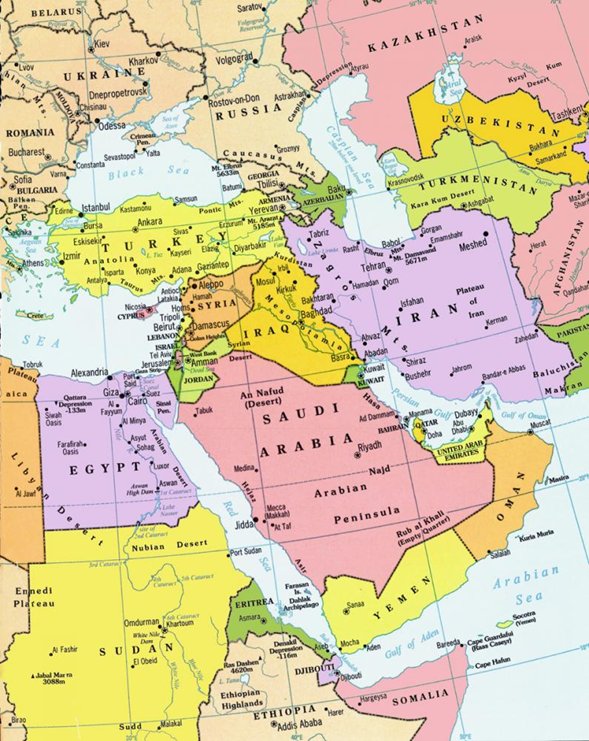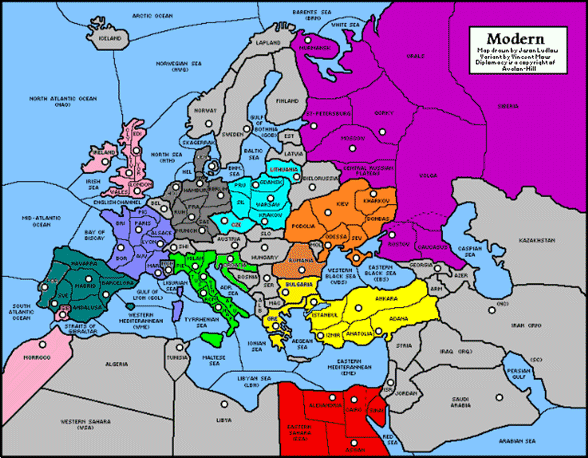My friend, Mario Huys, wrote an elegant and thoughtful piece called "The Modern Art of Love" about changing the Modern variant to include Slovenia.
His arguments (though written more eloquently) were basically:
- Slovenia is a country, and big enough, so it should be on the map
- The game impact of adding a Slovenia neutral space is not so bad
I disagree, and will refute both arguments one at a time.
An Important Country — Yes, but…
First, itís true of course that Slovenia is a country. No one disputes that. Itís a beautiful place, too!
But this is a red herring. Being a country (of two million population even) does not necessarily justify getting a space on the Modern variant board.
Some sub-arguments to this were that players of the Modern variant could not locate Slovenia on a map. Though this is not a job of the Modern variant, the argument also questions the intelligence of Diplomacy players, who tend to have a greater interest in maps than the average person. And as Marioís suggestion is to create a land-locked Slovenia without a coast, one could argue that this would make players falsely learn that Slovenia is a land-locked country.
The same argument could be used for choosing, which cities in a country should be supply centers.
Should these always be the four largest cities? If one goes down this path, then there is little left for the designer to do to design the variant. Gibraltar has a population of 34,000 — should it be an SC? Perhaps not, but making it one is part of the flavour of the Modern variant.
And though Mario states that the next country that was not chosen is Luxemburg, with a quarter of the population, there is also Kosovo (1.8 million vs 2.0 million for Slovenia), Cyprus (almost a million) as well as a host of smaller countries like Malta…
Furthermore, may I remind my friend that the map actually also includes North Africa and the Middle-East, and much larger countries that Slovenia (both in population and often also in land mass) have been excluded from the map: Yemen (26,5 million), UAE (9 million),Lebanon (4.3 million), Oman (4.2 million), Kuwait (4 million), Qatar (2.2 million), to name just those that have more people than Slovenia (and without naming Sudan). Turkmenistan (4.4 million) has also been "included" in Kazakhstan on the map, even though it borders the Caspian Sea between Kazakhstan and Iran. One could argue that if there is a country that many players would not be able to place on a map, then this would be it.

(Click for a full-size view in a separate window)
And of course, Slovenia is still on the map — the land is still there and hasnít disappeared into some void — it was effectively merged with Croatia (just as the other countries above are included in the territories of others on the map). Of course, this may offend some sensibilities, and the name that was chosen was Croatia, rather than Slovenia, as Croatia has over twice the population, as well as a bigger territory. If you really would like, think of the space as Croatia-Slovenia.
The Proof is in the Pudding
I would like to state however, that all the arguments above are essentially pointless. The real reason that Slovenia does not have its own space in the Modern variant, is through design. When creating the variant, and through extensive play-testing, it was felt that better game play was achieved without Slovenia than with it.
Letís look into this for both year 1 (1995), later game play, and Italyís general position on the board.
In the Beginning, there was…
In 1995, as part of game design, I have tried to balance the creation of contested spaces between several countries, to increase the need for choices and diplomacy between the great powers, and secure neutral SCs, basically neutral SCs the power is sure to be able to take if it wants.

(Click for a full-size view in a separate window)
(Map above with secure SCs coloured in the colour of the relevant Great Power)
The secure neutral SCs in the Modern Variant are as follows:
- Britain — Ireland, Morocco (though taking Morocco means giving up Gibraltar)
- Egypt — Israel
- France — Monaco
- Germany — Holland or Denmark
- Italy — Croatia
- Poland — Czech Republic, Lithuania (two for Poland, as they only start with 3 SCs)
- Russia — None (but Russia starts with 5 SCs)
- Spain — Portugal
- Turkey — Bulgaria OR Greece
- Ukraine — Rumania
As Mario points out, adding Slovenia with a coast on the Adriatic between Croatia and Venice to the map means that Italy is only guaranteed Croatia if she moves Milan to Austria in her opening move, to bounce a possible move there from Germany. This reduces Italyís opening flexibility, and creates an initial imbalance in the game, especially for a central power.
Therefore, Mario proposes a Slovenia — without a coast. The only border change (other than the new space itself) then is the separation of Croatia from Hungary. This does not affect year one play significantly.
Look Out Above — the End is Near
Later in the game, whether in the midgame or the endgame, the absence of a border between Austria and Croatia affects game play significantly.
One point is that foreign powers retreating from Austria could no longer "take" an empty Croatia, slowing down a quick southern stab of a northern power like Germany, or a quick play for Austria by Italy.
Another point is that it would be easier for Turkey and Italy to agree to DMZ Croatia and Serbia (assuming Turkey held the latter). Italy could still place a unit in Slovenia to support or attack Austria, without needing to occupy Croatia. This would affect game play as well.
The addition of Slovenia also detracts from another element of the Modern variant design — the wing Units. For those who do not remember, Modern was designed to be played with a third type of unit, in addition to armies and fleets. The wing unit can move both over land and sea spaces, but cannot convoy, and can only blockade neutral SCs (preventing the SC from being used to support a unit if occupied in the fall season, but not changing ownership).
One of the main reasons for including Wing units, was to allow northern powers access to the southern seas and vice versa, thus providing flexibility and a way around some naval blockades. One can easily imagine Germany having a Wing in Austria to protect her southern flank, while not overly threatening Italy (as it could not "take" an SC in the case of a stab). Such a unit is only two moves away from the Adriatic sea — via Croatia.
I realise that Modern is often played without Wings, so I would add that the distance between Austria and Serbia/Bosnia increases with the inclusion of Slovenia, affecting mid to end game flow.
Itís not all about Italy
Italy occupies a position in the middle of the board. As Mario points out, it is often do or die for Italy as a result. This is also actually the situation for the other central powers in the Modern variant — Germany, Poland and to some extent, Ukraine, Turkey and France. By design, they were given access to more neutral SCs.
A change Germany or Poland have sometimes achieved good results by leveraging ownership of Austria and the Czech Republic or Hungary to move into the northern Balkans. Slovenia would make this more difficult for them and thus shift the balance of power southwards in the variant.
The above are just two examples of what may happen to game play. In the end, the point is not to select, which is better, but just to show that game play would change significantly. Such a change in effect creates a new Variant. There has been a lot of game play of the Modern variant, and I would suggest not making changes that invalidate the cumulative experience and history we have built up.
All in all, I prefer keeping Italy and the Balkans closer to Austria and Germany/Poland. As Sun Tzu said in the Art of War, "Keep your friends close, and your enemies closer" . And Diplomacy is, after all, more about the Art of War than the Art of Love…
 |
Vincent Mous (japan.vincent@gmail.com) |
If you wish to e-mail feedback on this article to the author, and clicking on the envelope above does not work for you, feel free to use the "Dear DP..." mail interface.

